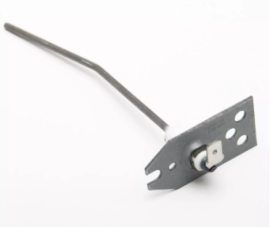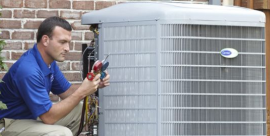Can a furnace be repaired?


Although a gas furnace is a complicated HVAC system endowed with numerous safety devices and interlock switches to prevent fires and carbon monoxide poisoning. Producing heat using a gas heat exchanger can be dangerous if combustion isn’t controlled properly. Common furnace problems can sometimes be easily resolved using basic troubleshooting.
Follow the tips in the owner’s manual before calling customer service for a service appointment. You may be able to repair the furnace yourself by replacing the furnace filter or opening the gas valve. A clogged air filter is one of the most common causes of furnace failures. Eliminate unnecessary service calls by conducting basic troubleshooting before calling for service.
Most common furnace repairs
When basic troubleshooting doesn’t restore heating air to your home, you’ll likely be facing one of these common furnace repairs:
No power. Restoring power to the furnace can be as simple as resetting the house circuit breaker if it’s tripped. Other problems that can prevent the furnace from powering up include a shut off power switch, disconnected wiring, blown overcurrent protection device, failed furnace door switch, defective thermostat transformer, failed thermostat or a bad electronic control board. You can check the power switch yourself. The power switch is typically a light switch next to the furnace that controls power going to the furnace. Turn on that switch if it’s shut off. If you’re confident that you can safely check furnace wiring yourself, shut off the house circuit breaker for the furnace and check wiring connections to the power switch, overcurrent protection device, power disconnect device, furnace door switch, electronic control board, thermostat transformer and thermostat. If you can’t find a wiring failure (or if this list of wiring checks seems overwhelming to you), have a service technician diagnose and repair your furnace.
Thermostat isn’t working. Failure of the thermostat could be caused by a wiring failure, bad transformer, or a failed thermostat. Disconnecting power to the furnace and checking the wiring connections to the thermostat is fairly simple. Reconnecting any loose wires may fix the thermostat. If you find no wiring problems, replacing the thermostat may fix your furnace. If these troubleshooting steps don’t help, then a service technician will likely need to fix the furnace.
Lack of heating airflow. When the blower motor runs but not much air flows through the vents to heat your home, a clogged air filter is often the cause of this problem. Check the furnace filter and replace it if it’s dirty. If that doesn’t help resolve the issue, then a bad blower motor or a worn drive belt could be preventing the blower fan from moving air properly through the furnace.
Ignition failure. You hear the igniter clicking but the burner won’t light. This problem can be caused by a wiring failure, bad igniter, defective flame sensor, failed limit switch, bad pressure switch, failed induced draft blower or a defective control board. A gas supply failure can also prevent the burner from igniting. Make sure that the gas supply valve for your furnace it open. This easy troubleshooting step may fix the problem quickly. If the furnace is getting a good gas supply, then you’ll likely need to have a service technician find and fix the cause of the ignition failure. Furnace ignition systems typically have complicated safeguards and interlock switches to protect against fire and carbon monoxide poisoning.
Cracked or damaged burner assembly. The burner assembly can eventually corrode and wear out over time. When the flame roll-out switch detects an uncontrolled burner flame or the high-limit switch detects abnormally high temperatures in the furnace, it’s time to check the heat exchanger. Visible damage or corrosion on the burner assembly indicates that it’s likely time to replace the heat exchanger. If you don’t see obvious signs of deterioration in the burner assembly when the flame roll-out switch starts tripping frequently or the high-limit switch trips often, then you’ll need to have a service technician examine the furnace and provide you with recommendations for repair.
Furnace door switch failure. An interlock switch on the furnace door monitors the furnace door’s position. The furnace won’t heat if the control detects that the furnace door isn’t fully shut. This switch is easily accessible and you can check it using a multimeter. Disconnect electrical power to the furnace by shutting off the house circuit breaker for the unit. Open the furnace door and disconnect the wires from the switch. Engage the switch by hand to simulate the door being closed while checking continuity through the switch. On most furnaces, your meter will measure near 0 ohms of resistance (continuity) when the switch is engaged to sense the furnace door shut. If the meter measures infinite resistance then the door switch is likely bad. Measure resistance with the switch actuator released. If the meter measures the same resistance with the actuator pushed in and released, then the door switch is definitely bad so replace it. If you aren’t comfortable with performing the diagnosis and repair yourself, have a service technician repair the furnace.
Pressure switch failure. High-efficiency gas furnaces us a pressure switch to monitor induced draft blower performance. The furnace won’t ignite or won’t work if the pressure switch doesn’t detect proper air flow from the induced draft blower. Some furnaces display an error code when the pressure switch fails. Replacing the pressure switch or a bad induced draft blower when the error code occurs will fix the furnace. A service technician typically needs to complete this type of repair. If your furnace doesn’t display error codes, you’ll likely need to have a technician diagnose the furnace when it isn’t working due to a bad pressure switch or induced draft blower.
Just about any type of furnace failure can be fixed—either by you or by a service technician.
How much do furnace repairs cost?
Normal wear and tear eventually takes its toll on your furnace. Simple furnace repairs such as a failed switch can cost less than $150—even less if you find and replace the bad switch yourself. Serious repairs such as replacing a blower motor or heat exchanger in your furnace can easily cost more than $1000.
When you’re facing a major repair costing over $1000 and your furnace is over 10 years old, you may consider replacing your entire heating and cooling system instead of making the expensive repair. Even after repairing an older air conditioning and heating system, you may face frequent service calls within the next few years. High efficiency furnaces and HVAC systems help you save money on energy bills. Replacing an old system with a new, more efficient unit will help pay for itself with lower energy bills over time.
Although practically any furnace failure can be repaired, calculate the economic impact of making the repair versus buying a new, more efficient system before scheduling the repair. Choose the path that best suits your needs.
Most common symptoms to help you fix your heating & cooling combined units
Choose a symptom to see related heating and air conditioning system repairs.
Thermostat problem, clogged air filter, burner failure…
Dirty air filter, clogged condenser coils, low refrigerant charge, faulty compressor…
Thermostat problems, bad compressor/condenser fan capacitor, lack of refrigerant, failed compressor…
Main causes: errant thermostat settings, lack of electrical power, clogged drain line, wiring failure, control failure.…
Main causes: Errant thermostat settings, lack of power, bad interlock switches, lack of exhaust ventilation, wiring fail…
Dirty flame sensor, failed flame sensor, damaged burner, bad high limit switch…
Most common repair guides to help fix your heating & cooling combined units
These step-by-step repair guides will help you safely fix what’s broken on your HVAC system.

How to unclog the air conditioner drain line
The condensate drain line for your central air conditioner can clog with mold and mildew. Water will back up and start d…

How to replace the furnace flame sensor
The flame sensor detects when furnace burner flames are lit. You may need to replace the flame sensor if flames only sta…

How to replace a heating and air conditioning system thermostat
The control thermostat for your HVAC system can stop working. This repair guide shows how to replace it.…
Effective articles & videos to help repair your heating & cooling combined units
Use the advice and tips in these articles and videos to get the most out of your HVAC system.

Learn how to maintain your central air conditioner to keep it running smoothly all summer long.…

Learn about all the convenient features on our Sears PartsDirect website that make your parts purchases easier.…

Get answers to frequently asked questions about Sears and Sears PartsDirect.…